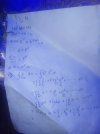Navigation
More options
You are using an out of date browser. It may not display this or other websites correctly.
You should upgrade or use an alternative browser.
You should upgrade or use an alternative browser.
Unapata zawadi nzuri ukipata jibu sahihi la hesabu hii ya calculus
Mgogo Vitani
JF-Expert Member
- Jul 1, 2017
- 482
- 840
Mokaze
JF-Expert Member
- Aug 3, 2018
- 14,376
- 14,870
To all students and graduates;
QN: Integrate with respect to x: 1/lnx (one over natural logarithm of x)
The answer is:-
×/lnx+2lnx+c
Upepo wa Pesa
JF-Expert Member
- Aug 8, 2015
- 21,237
- 34,185
Unadhani swali lingekua refu kama maswali ya mfekane war?Hapo ndio swali tayari?
Mtanzatozo
JF-Expert Member
- Mar 2, 2016
- 972
- 1,163
itakuwa katumia njia ya nyerere kupata uhuru
Mokaze
JF-Expert Member
- Aug 3, 2018
- 14,376
- 14,870
Hapana, siyo jibu lake. Umetumia njia gani kupata jibu hilo?
Kweli kuna mahali nilikosea, Subiri kidogo nilikalie kitako.
Eng. Zezudu
JF-Expert Member
- Aug 23, 2012
- 7,806
- 10,774
Uko sawa Ila hapo ulipo fika kabla ya kufanya expansion ya e exponent u ilitakiwa utumie integration by part.Kama uko advance huwezi hilo swali umeishajoking
Ila hapo ukiweza kuintegrate e* utakuwa umemaliza hilo swali
Sina uhakika na nilivyosolve ila uelekeo ndio huo huo maana ni kitambo sanaView attachment 1711681
Sent using Jamii Forums mobile app
Eng. Zezudu
JF-Expert Member
- Aug 23, 2012
- 7,806
- 10,774
Leta Ela nifanye integration faster Yani ,Mana me ndo chandi mwenyewe.To all students and graduates;
QN: Integrate with respect to x: 1/lnx (one over natural logarithm of x)
Sent using Jamii Forums mobile app
mzalendo namba moja
JF-Expert Member
- Oct 26, 2018
- 390
- 476
If ln(x) is 1/x.
But wait! How do we know that the derivative of ln(x) is 1/x? The if y=ln(x), then the derivative of ln(x) at x is the multiplicative inverse of the derivative of e^y at y. (Think about what happens to the slope of the tangent line when you swap the x and y axes.) In other words,
ddxln(x)=(ddyey)−1.ddxln(x)=(ddyey)−1.
But we know that the derivative of e^y is just e^y, so the right-hand side simplifies to
(ey)−1=x−1=1x(ey)−1=x−1=1x.
But wait! How do we know that the derivative of e^y is e^y? Well, that's the definition of the exponential function (or a theorem, if you use a different definition for e)
But wait! How do we know that the derivative of ln(x) is 1/x? The if y=ln(x), then the derivative of ln(x) at x is the multiplicative inverse of the derivative of e^y at y. (Think about what happens to the slope of the tangent line when you swap the x and y axes.) In other words,
ddxln(x)=(ddyey)−1.ddxln(x)=(ddyey)−1.
But we know that the derivative of e^y is just e^y, so the right-hand side simplifies to
(ey)−1=x−1=1x(ey)−1=x−1=1x.
But wait! How do we know that the derivative of e^y is e^y? Well, that's the definition of the exponential function (or a theorem, if you use a different definition for e)
Makanyaga
JF-Expert Member
- Sep 28, 2007
- 10,318
- 6,846
- Thread starter
- #15
Hili ni swali jingine au ni jibu kwa swali lililopo kwenye mada?If ln(x) is 1/x.
But wait! How do we know that the derivative of ln(x) is 1/x? The if y=ln(x), then the derivative of ln(x) at x is the multiplicative inverse of the derivative of e^y at y. (Think about what happens to the slope of the tangent line when you swap the x and y axes.) In other words,
ddxln(x)=(ddyey)−1.ddxln(x)=(ddyey)−1.
But we know that the derivative of e^y is just e^y, so the right-hand side simplifies to
(ey)−1=x−1=1x(ey)−1=x−1=1x.
But wait! How do we know that the derivative of e^y is e^y? Well, that's the definition of the exponential function (or a theorem, if you use a different definition for e)
mtzedi
JF-Expert Member
- Dec 13, 2011
- 5,568
- 5,575
Hana lolote yule dogo tofautisha hesabu na hisabati. Anachoweza ni hesabu.Ngoja nimpigie sim yule dogo jiniaz wa jimboni kwa Tale
black short
JF-Expert Member
- Nov 16, 2019
- 519
- 969
Hako kaswali kameleta maelezo yote hayo?Kama uko advance huwezi hilo swali umeishajoking
Ila hapo ukiweza kuintegrate e* utakuwa umemaliza hilo swali
Sina uhakika na nilivyosolve ila uelekeo ndio huo huo maana ni kitambo sanaView attachment 1711681
jooohs
JF-Expert Member
- Jul 26, 2017
- 2,057
- 8,558
Maelezo yapi ndugu?Hako kaswali kameleta maelezo yote hayo?
EllySkyWilly
JF-Expert Member
- Aug 28, 2020
- 2,204
- 2,083
To all students and graduates;
QN: Integrate with respect to x: 1/lnx (one over natural logarithm of x)
Give me that money I'm waiting it.
Similar Discussions
-
Teacher Training Coordinator at Project Zawadi March, 2024
- Started by Jamii Opportunities
- Replies: 12
-
District Manager/Cluster Lead at THPS February, 2024
- Started by Jamii Opportunities
- Replies: 2
-
Muhimbili University of Health and Allied Sciences(MUHAS) SPECIAL THREAD
- Started by Joyboy
- Replies: 62
-
Majibu sahihi ya swali la msingi "Nifanye biashara gani?"
- Started by Napoleon the second
- Replies: 0
-
Tetesi: Upholding Justice for National Welfare
- Started by Respicius Mwijage
- Replies: 0




